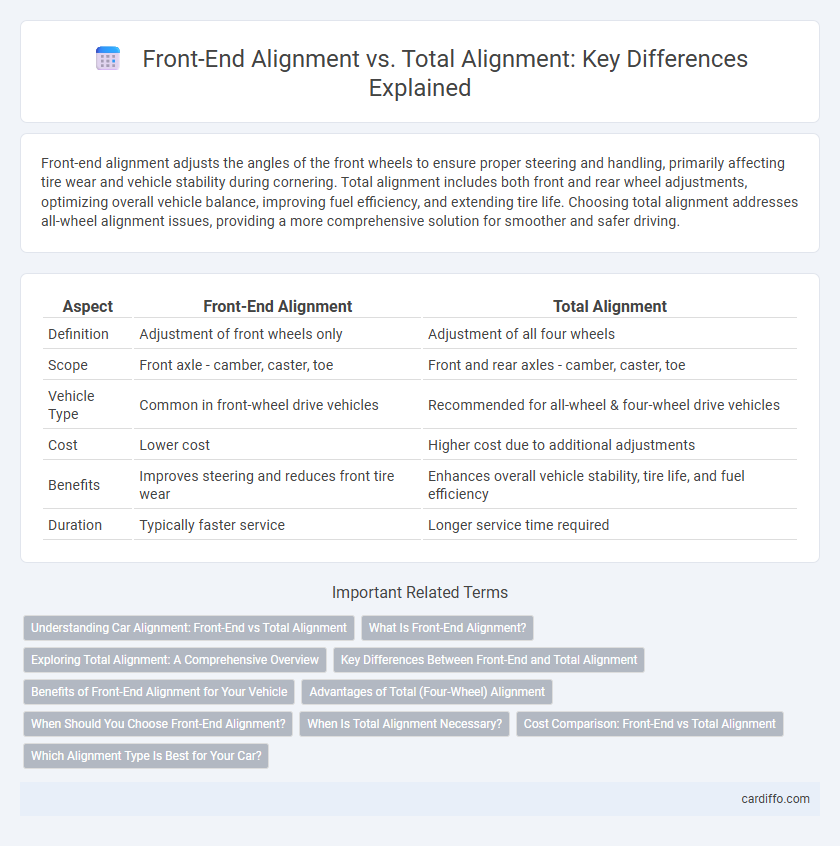Front-end alignment adjusts the angles of the front wheels to ensure proper steering and handling, primarily affecting tire wear and vehicle stability during cornering. Total alignment includes both front and rear wheel adjustments, optimizing overall vehicle balance, improving fuel efficiency, and extending tire life. Choosing total alignment addresses all-wheel alignment issues, providing a more comprehensive solution for smoother and safer driving.
Table of Comparison
| Aspect | Front-End Alignment | Total Alignment |
|---|---|---|
| Definition | Adjustment of front wheels only | Adjustment of all four wheels |
| Scope | Front axle - camber, caster, toe | Front and rear axles - camber, caster, toe |
| Vehicle Type | Common in front-wheel drive vehicles | Recommended for all-wheel & four-wheel drive vehicles |
| Cost | Lower cost | Higher cost due to additional adjustments |
| Benefits | Improves steering and reduces front tire wear | Enhances overall vehicle stability, tire life, and fuel efficiency |
| Duration | Typically faster service | Longer service time required |
Understanding Car Alignment: Front-End vs Total Alignment
Front-end alignment focuses exclusively on adjusting the angles of the front wheels, including camber, caster, and toe, to ensure proper steering response and tire wear. Total alignment extends these adjustments to both front and rear wheels, optimizing overall vehicle stability, handling, and tire longevity. Proper understanding of front-end versus total alignment is crucial for maintaining precise wheel angles, improving safety, and maximizing tire performance.
What Is Front-End Alignment?
Front-end alignment refers to the precise adjustment of the vehicle's front suspension, including the angles of the front wheels such as camber, toe, and caster. Proper front-end alignment ensures optimal steering response, improved tire wear, and enhanced vehicle handling by aligning the wheels according to manufacturer specifications. Unlike total alignment, which includes both front and rear wheel adjustments, front-end alignment is typically performed on vehicles with a rigid rear axle or in less complex suspension systems.
Exploring Total Alignment: A Comprehensive Overview
Total alignment encompasses the precise adjustment of all four wheels to optimize vehicle stability, tire wear, and handling performance beyond the front-end alignment that only adjusts the front wheels. It addresses camber, caster, and toe angles on both the front and rear axles, ensuring balanced traction and improved fuel efficiency across diverse driving conditions. Comprehensive total alignment reduces uneven tire wear, enhances steering response, and extends overall vehicle lifespan by maintaining optimal contact with road surfaces.
Key Differences Between Front-End and Total Alignment
Front-end alignment adjusts the angles of the front wheels, including camber, caster, and toe, directly affecting steering response and tire wear. Total alignment encompasses both front and rear wheel alignments, ensuring overall vehicle stability, handling balance, and proper tire contact with the road. Key differences lie in the scope of adjustments and their impact on vehicle dynamics, with front-end alignment focused on directional control and total alignment optimizing comprehensive performance and safety.
Benefits of Front-End Alignment for Your Vehicle
Front-end alignment focuses on adjusting the angles of the front wheels, which directly impacts steering response, tire wear, and fuel efficiency. Proper front-end alignment ensures smoother handling and improves safety by maintaining optimal tire contact with the road. Compared to total alignment, front-end alignment is often quicker and more cost-effective while still resolving common alignment issues.
Advantages of Total (Four-Wheel) Alignment
Total alignment, also known as four-wheel alignment, ensures precise adjustment of all four wheels, improving vehicle handling and tire longevity compared to front-end alignment, which only adjusts the front wheels. This comprehensive approach corrects rear wheel angles, enhancing overall stability and reducing uneven tire wear. By optimizing the alignment of all wheels, total alignment provides better fuel efficiency and a safer driving experience.
When Should You Choose Front-End Alignment?
Front-end alignment is ideal when tire wear is uneven on the front tires or when steering issues such as pulling or drifting occur, as it specifically addresses front wheel angles like camber, caster, and toe. Choosing front-end alignment is often more cost-effective and faster than total alignment, making it suitable for routine maintenance when the rear alignment is already within specifications. It is essential to select front-end alignment when the vehicle's rear wheels are fixed or non-adjustable to ensure proper front wheel alignment without altering the rear settings.
When Is Total Alignment Necessary?
Total alignment becomes necessary when multiple wheels need adjustment to ensure the vehicle maintains optimal handling, tire wear, and safety, especially after suspension repairs or significant impacts. Front-end alignment only adjusts the front wheels, which may suffice for minor corrections or front-wheel-drive vehicles where rear alignment remains factory-set. Vehicles with all-wheel drive, or those exhibiting uneven tire wear and instability, benefit from total alignment to achieve precise control and balanced performance.
Cost Comparison: Front-End vs Total Alignment
Front-end alignment typically costs less than total alignment because it involves adjusting only the front wheels, which are more prone to wear and impact steering. Total alignment includes the rear wheels, requiring more time, precision, and equipment, thus increasing the overall expense. Investing in total alignment ensures better tire longevity and vehicle stability, often reducing long-term maintenance costs despite the higher upfront price.
Which Alignment Type Is Best for Your Car?
Front-end alignment adjusts only the front wheels, improving steering control and tire wear for vehicles with independent front suspensions, making it cost-effective for routine maintenance. Total alignment includes both front and rear wheel adjustments, essential for vehicles with rear-wheel drive or all-wheel drive to ensure proper handling, stability, and even tire wear across all wheels. Choosing the best alignment type depends on your car's drivetrain, suspension design, and manufacturer recommendations to optimize performance and safety.
Front-End Alignment vs Total Alignment Infographic

 cardiffo.com
cardiffo.com